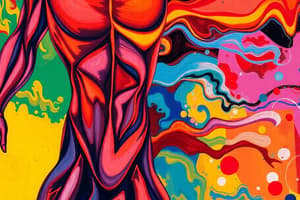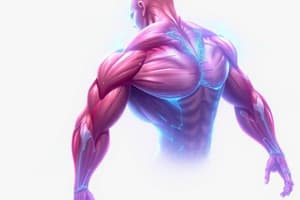Podcast
Questions and Answers
Which of the following is NOT a primary function of skeletal muscle?
Which of the following is NOT a primary function of skeletal muscle?
- Maintenance of posture
- Regulating blood glucose levels
- Movement of the skeleton
- Pumping blood throughout the body (correct)
What property allows muscle tissue to shorten and thicken, generating force?
What property allows muscle tissue to shorten and thicken, generating force?
- Excitability
- Contractility (correct)
- Extensibility
- Elasticity
A muscle that assists the prime mover in performing its action is classified as a(n):
A muscle that assists the prime mover in performing its action is classified as a(n):
- Fixator
- Agonist
- Synergist (correct)
- Antagonist
Which term is used to describe a muscle that prevents movement of a bone?
Which term is used to describe a muscle that prevents movement of a bone?
If a muscle's name includes the term 'rectus', what does this indicate about the muscle's characteristics?
If a muscle's name includes the term 'rectus', what does this indicate about the muscle's characteristics?
The biceps brachii is an example of what type of fascicle arrangement?
The biceps brachii is an example of what type of fascicle arrangement?
What type of muscle attachment involves a broad, flat sheet of connective tissue?
What type of muscle attachment involves a broad, flat sheet of connective tissue?
The point of muscle attachment on the less movable bone is referred to as the:
The point of muscle attachment on the less movable bone is referred to as the:
What does the innervation of a muscle refer to?
What does the innervation of a muscle refer to?
Which type of muscle tissue is responsible for venous return during dynamic exercise?
Which type of muscle tissue is responsible for venous return during dynamic exercise?
During periods of malnutrition or starvation, what role can protein from muscles play?
During periods of malnutrition or starvation, what role can protein from muscles play?
Which characteristic of muscle tissue allows it to stretch significantly without being damaged?
Which characteristic of muscle tissue allows it to stretch significantly without being damaged?
Which of these arrangements describes convergent fascicles?
Which of these arrangements describes convergent fascicles?
If damage occurs to the spinal nerves that innervate muscles, what can testing muscle innervation help diagnose?
If damage occurs to the spinal nerves that innervate muscles, what can testing muscle innervation help diagnose?
The orbicularis oris muscle, which encircles the mouth, has what type of fasicle arrangement?
The orbicularis oris muscle, which encircles the mouth, has what type of fasicle arrangement?
Which type of muscle fiber arrangement best describes the rectus femoris?
Which type of muscle fiber arrangement best describes the rectus femoris?
Which of the following characteristics describes the role of a retinaculum?
Which of the following characteristics describes the role of a retinaculum?
Which of the following describes the action of antagonists?
Which of the following describes the action of antagonists?
Which type of muscle tissue is responsible for regulating blood sugar concentration?
Which type of muscle tissue is responsible for regulating blood sugar concentration?
Which characteristic allows muscle tissue to respond to stimulus by producing electrical signals?
Which characteristic allows muscle tissue to respond to stimulus by producing electrical signals?
Flashcards
Skeletal Muscle Movement
Skeletal Muscle Movement
Skeletal muscle action that moves the skeleton.
Cardiac Muscle Movement
Cardiac Muscle Movement
Cardiac muscle action that moves the blood.
Smooth Muscle Movement
Smooth Muscle Movement
Smooth muscle action that moves "stuff" through hollow organs.
Posture
Posture
Signup and view all the flashcards
Thermogenesis
Thermogenesis
Signup and view all the flashcards
Venous Return
Venous Return
Signup and view all the flashcards
Sphincters
Sphincters
Signup and view all the flashcards
Contractility
Contractility
Signup and view all the flashcards
Excitability
Excitability
Signup and view all the flashcards
Extensibility
Extensibility
Signup and view all the flashcards
Elasticity
Elasticity
Signup and view all the flashcards
Agonist
Agonist
Signup and view all the flashcards
Antagonist
Antagonist
Signup and view all the flashcards
Synergist
Synergist
Signup and view all the flashcards
Fixator
Fixator
Signup and view all the flashcards
Origin
Origin
Signup and view all the flashcards
Insertion
Insertion
Signup and view all the flashcards
Tendons
Tendons
Signup and view all the flashcards
Retinaculum
Retinaculum
Signup and view all the flashcards
Muscle Innervation
Muscle Innervation
Signup and view all the flashcards
Study Notes
- Muscles make up nearly half of the body’s weight.
- There are approximately 600 human skeletal muscles.
- The three types of muscle tissue are: skeletal, cardiac, and smooth.
- Muscles are specialized to convert the chemical energy in ATP into mechanical motion.
Functions of Muscle
- Movement is achieved through muscle contractions.
- Skeletal muscles move the skeleton.
- Cardiac muscle moves blood.
- Smooth muscle moves "stuff" through hollow organs.
- Skeletal muscles maintain posture and provide joint stabilization.
- Thermogenesis, or heat generation, occurs when contracting skeletal muscles produce approximately 85% of body heat through working out or shivering.
- Venous Return: Muscle pump action during dynamic exercise pumps blood back to the left ventricle, increasing venous blood return via rhythmic contraction/relaxation.
- Protein becomes an alternative energy source during malnutrition or starvation.
- Glycemic Control: Muscles absorb and store glucose, regulating blood sugar within a normal range.
- Sphincters, which are internal smooth muscle rings, control the movement of food, blood, and other materials within the body, controlling openings and passageways.
Functional Characteristics of Muscle
- Contractility is the ability to shorten and thicken, generating force to do work, and muscles only pull.
- Excitability is the ability to respond to stimuli by producing electrical signals.
- Extensibility is the ability to stretch without being damaged.
- Elasticity is the ability to return to its original length/shape following distension.
Classification by Function
- Action: effect produced by a muscle to produce or prevent movement.
- Four Functional Groups of muscles: Agonists, Antagonists, Synergists, and Fixators.
- Agonists (Prime Movers): provide the major force for producing a specific movement.
- Antagonists: oppose or reverse a particular movement.
- Synergists: muscles that aid the prime mover.
- Fixators: muscles that prevent movement of bone.
- Muscles may perform any of these roles depending on the movement.
Naming Skeletal Muscles
- Latin names explain the Muscle's Location, Shape, Relative Size, Fiber Direction, Attachment Location, Number of Origins, and Action.
- Location: Intercostal (between ribs)
- Shape: Deltoid (triangle)
- Relative Size: Maximus, Minimus, Longus, Brevis
- Direction of Fibers: Rectus, Transverse, Oblique
- Location of Attachments: Sternocleidomastoid
- Number of Origins: Biceps, Triceps
- Actions: Flexor, Extensor, Abductor, Adductor
Muscle Mechanics: Arrangement of Fascicles
- Circular: Fascicles are arranged in concentric rings (e.g., orbicularis oris).
- Convergent: Fascicles converge toward a single tendon insertion (e.g., pectoralis major).
- Parallel: Fascicles are parallel to the long axis of a straplike muscle (e.g., sartorius).
- Fusiform: Spindle-shaped muscles with parallel fibers (e.g., biceps brachii).
- Pennate: Short fascicles attach obliquely to a central tendon running the muscle's length (e.g., rectus femoris).
Muscle Attachments
- Indirect attachment to bone: tendons connect muscle to bone.
- Collagen fibers of the endo-, peri-, and epimysium continue into the tendon and from there into periosteum and the matrix of bone.
- Aponeurosis: tendon is a broad, flat sheet.
- Retinaculum: connective tissue band that tendons from separate muscles pass under.
Sites of Attachment
- Origin: the point of muscle attachment on the immovable or less movable bone; in limbs, the origin is usually proximal to the insertion.
- Insertion: the point of muscle attachment that moves toward the origin.
Muscle Innervation
- Innervation: refers to the identity of the nerve that stimulates it.
- Knowing innervation enables diagnosis of nerve, spinal cord, and brainstem injuries from muscle tests.
- Spinal nerves arise from the spinal cord.
- They emerge through intervertebral foramina.
- Spinal Nerves immediately branch into posterior and anterior rami.
- Spinal Nerves innervate muscles below the neck.
- Plexus: web-like network of spinal nerves adjacent to the vertebral column.
- Cranial nerves arise from the base of the brain.
- Cranial Nerves emerge through skull foramina.
- Cranial Nerves innervate the muscles of the head and neck.
- Cranial Nerves are numbered CN I to CN XII.
Studying That Suits You
Use AI to generate personalized quizzes and flashcards to suit your learning preferences.



